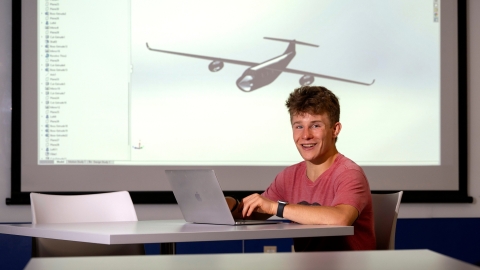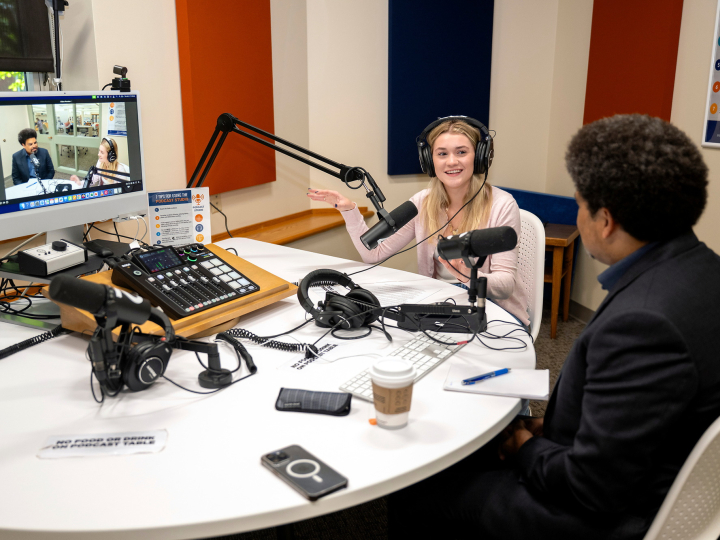
Kade Davidheiser '27, Biology and Mechanical Engineering
September 24, 2025
Kade Davidheiser '27, mechanical engineering and biology, spent his summer researching how electric aircraft can be integrated into the national air fleet to reduce carbon emissions. Photo by Emily Paine, Marketing & Communications
Kade Davidheiser '27 always hoped that wrestling would take him places in life. "The older I got, the more I knew competing at the Division I level was the goal," says Davidheiser, who first stepped onto the mat at the age of five. After being heavily recruited by different universities, it was a visit to Bucknell that helped him make his decision. "I could tell from the vibe here that I knew I would be putting in the work, not just with wrestling. I knew I would be set up for success in my career."
When it came to choosing a major, the Barto, Pa., native considered several paths. His experience as a wrestler sparked an interest in biology, particularly in understanding movement and mechanics. A family connection to aviation inspired a lifelong fascination with aerospace. "My grandfather was in the air force, so his interest in planes was something that he passed on to me," says Davidheiser.
At Bucknell, he didn't have to choose one major over the other. As a biology and mechanical engineering double-major, Davidheiser has found ways to blend the disciplines through research projects that have allowed him to explore the overlap between the two fields.
Through the Bucknell Program for Undergraduate Research, Davidheiser worked with Professor William Scott, mechanical engineering, on a biomechanics project. "I actually built a robot using this material called Filaflex, which is a highly elastic, thermoplastic polyurethane," he says. "We were able to print legs out of this material and study how the robot jumped, walked and moved."
He also had the opportunity to further develop his interest in aviation. In a summer research project with Professor Greg O'Neill, mechanical engineering, Davidheiser closely analyzed flight data from a single day to investigate what air travel reveals about carbon emissions. "We took a screenshot that captured a full day of the radar for the National Airspace System," says Davidheiser, who examined roughly 60,000 flights that occurred on March 24, 2024. The amount of data generated by a single day of air traffic in the United States is so great that the code to process it, which was written by O'Neill, took around a month to run. "We looked at everything — how many passengers are on a flight, how far the plane flew and the kilowatt-hours used by each flight," says Davidheiser.
Along with analyzing data, Davidheiser also built airplanes in SolidWorks, a 3D CAD (Computer-Aided Design) software. "I'm given the wing area, the length and the number of passengers. From there, I have to create a whole plane," he says. The design process is dynamic, and the shape and size of the aircraft change based on both data inputs and outputs. By modeling different types of planes, he and O'Neill could better understand the factors that inform carbon emissions and energy usage — and determine whether carbon emissions could be reduced by replacing petrol-based planes with electric aircraft.
For Davidheiser, a rigorous schedule is as challenging as it is rewarding. As a wrestler, he always knew he would have to work hard to compete at the Division I level. What he didn't know was just how many academic opportunities his athletic career would unlock. "Wrestling is what brought me here, and it's what has allowed me to do all of the cool things I'm doing now," he says.

